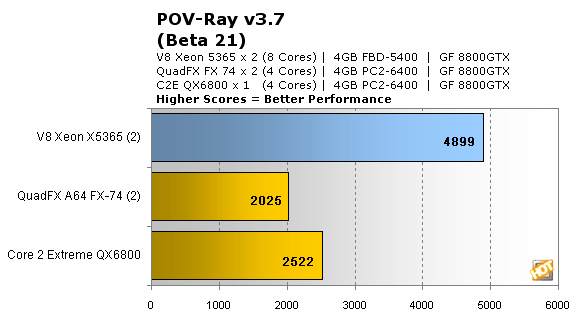Intel V8 Media Creation Platform - Dual Sockets - Dual Xeons
POV-Ray and Cinebench R9.5

POV-Ray , or the Persistence of Vision Ray-Tracer, is a top-notch open source tool for creating realistically lit 3D graphics artwork. We tested with POV-Ray's standard included benchmarking model on all of our test machines and recorded the scores reported for each. We shoudl also note that we used the latest 64-bit beta build of the program. Results are measured in pixels-per-second throughput.
![]()
POV Ray Performance
Details:
www.povray.org

POV-Ray is a true multi-threaded application that benefits greatly by having more CPU cores at its disposal. In this benchmark, the V8 rig outpaced the next fastest system, the QX6800, by over 94% and it was mroe than twice as fast as the QuadFX system. Wasn't there some hub-bub recently over a Barcelona system hitting just over 4000 in POV-Ray recently? A POV-Ray score of 4000 is so last year.
|
|
|
The Cinebench R9.5 benchmark is an OpenGL 3D rendering performance test, based on the commercially available Cinema 4D application. Cinema 4D from Maxon is a 3D Rendering and Animation tools suite used by many 3D Animation houses and producers like Sony Animation and many others. And of course it's very demanding of system processor resources.
This is a multi-threaded, multi-processor aware benchmark that renders a single 3D scene and tracks the length of the entire process. The time it took each test system to render the entire scene is represented in the graph below (listed in seconds).

Interestingly enough, all three of our test platforms rendered the Cinebench R9.5 scene in :44 seconds under Windows Vista Ultimate 64-bit, using the single-threaded test. The multi-threaded test, however, shows the true power of V8. In the MT test, the V8 rig rendered the entire scene in only 8 seconds - that's over 42% faster than the QX6800 and 38% faster than the dual FX-74 powered QuadFX system.






